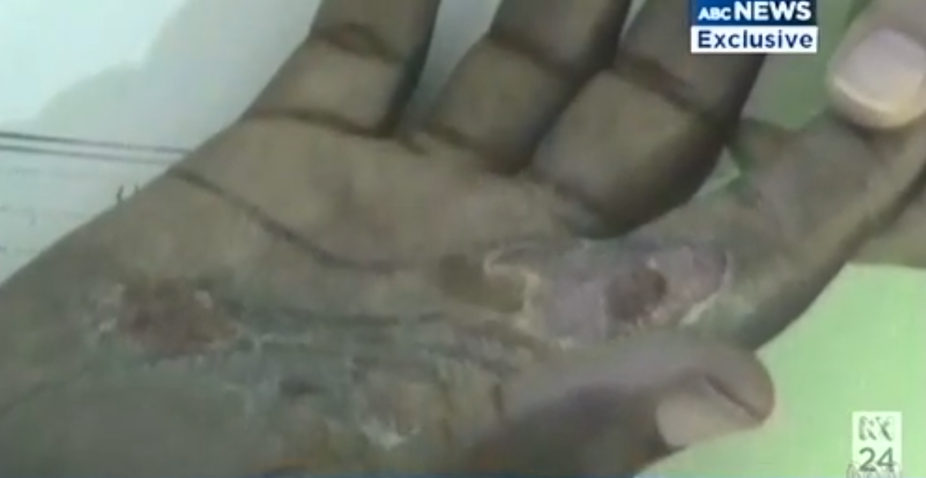The ABC’s handling of allegations that Australian Navy personnel deliberately injured asylum seekers has become nastily entangled with an array of complex issues.
These include: the politics of ABC bias; the politics of media business interests; the ethics of journalistic verification; the ethics of journalist accountability; the role of the media in a liberal democracy; and the question of censorship.
However, the central question concerns the ethics of journalistic verification. A central tenet of this is that the standard of proof required to justify accepting an allegation as credible should be commensurate with the seriousness of the allegation itself.
The allegations
The allegations that the navy inflicted cruel and inhumane punishment on asylum seekers by forcing them to place their bare hands on the hot engine pipes of their boat were extremely serious. A commensurately high standard of proof was required before any judgement could be made about their credibility.
That does not stop the media reporting the allegations, so long as a response is obtained from the accused party and no judgement is made about their credibility. Presentation of such serious allegations as if they are credible requires at least some first-hand testimony and corroboration and preferably some independent triangulation. For example, a medical practitioner could attest to the nature and likely cause of the injuries.
The initial reporting of these allegations, between January 7 and 10, was straightforward. The allegations were aired, along with a bald and uninformative statement of denial by the Defence Force chief, General David Hurley. On January 22, the ABC went further, saying that new footage “appears to back” the allegations.
The footage showed a close-up of a man’s palm apparently blistered by burns. The ABC reported that Indonesian authorities had confirmed that seven asylum seekers had received medical treatment for severe burns to their hands. Indonesian police reportedly said the burns were caused by Australian Navy personnel forcing them to hold onto hot pipes coming from the engine of the asylum seekers’ boat.
The ABC considered this entirely circumstantial and hearsay evidence to be a sufficient basis for judging that the allegations were apparently credible.
A rush to judgement
Thanks to the ABC’s Media Watch program, we now know that what little first-hand evidence the ABC later adduced told a different story.
Eight days after the judgement about the likely credibility of the allegations, an ABC reporter and cameraman interviewed four asylum seekers who had been aboard boats where these acts of brutality allegedly occurred.
In face-to-face interviews, one asylum seeker who claimed to have suffered burns said he stumbled against a hot engine after having been sprayed in the eyes by naval personnel. A second asylum seeker who was on another boat claimed to have been thrown against a hot engine. Neither claimed to have had his hands forcibly held against a hot pipe.
If judgement had been withheld – as it should have – until a sufficient standard of proof had been met, the ABC would have saved itself some acute and particularly ill-timed trouble.
Questions of accountability
On February 4, the ABC’s managing director, Mark Scott, and director of news, Kate Torney, issued a media release, the Jesuitical wording of which brings us to the second ethical issue here, that of media accountability.

Referring to the video evidence of the burnt hand, the statement said:
The ABC’s initial reports on the video said that the vision appeared to support the asylum seekers’ claims. That’s because it was the first concrete evidence that the injuries had occurred. What the video did not do was establish how those injuries occurred. The wording around the ABC’s initial reporting needed to be more precise on that point. We regret if our reporting led anyone to mistakenly assume that the ABC supported the asylum seekers’ claims. The ABC has always presented the allegations as just that – claims worthy of further investigation.
Too right it needed to be more precise, and assessments about what the video meant needed to be suspended until better evidence was available. As for mistaken assumptions, it is well established in media law – and equally well understood by journalists – that people take in the news impressionistically. They do not parse every sentence.
Journalists who create false impressions in the minds of their audience have only themselves to blame. In these ways, the ABC’s statement typifies the media’s conventional reluctance to own up.
Poor evidence of bias
None of these failings, however, support the accusations of bias that have been levelled at the ABC.
Failure to verify is not on its own evidence of bias. If it could be shown to be accompanied by some other culpable element such as conscious prejudice, suppression of available evidence or failure to give an opportunity to reply, then a case of bias might exist. However, there is no such evidence.
News Corp has characterised the ABC as treacherous and accused it of hating the navy. But News Corp has a commercial axe to grind with the ABC and isn’t to be taken seriously on this matter.
The government was given every opportunity to reply but was defeated by its own policy of censorship in respect of Operation Sovereign Borders.
Nor do these failings provide any support for prime minister Tony Abbott’s authoritarian proposition that the ABC should give Australia the benefit of the doubt on these issues.
Lessons of history
Give Australia the benefit of the doubt? Why? Australian governments have lied about these matters before.
During the 2001 federal election campaign, the ABC was rightly sceptical about the veracity of photos that the government asserted to be of asylum seekers throwing their children overboard. They turned out to be nothing of the kind.
The irony now is that the ABC has been insufficiently sceptical of another asylum seeker image, in this case the burnt-hand video. In journalism, it is always hazardous to suspend disbelief.

